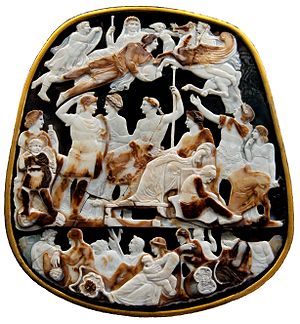Onyx is a gemstone, that is very popular in jewellery making. It belongs to the chalcedony family and along with agate, they are the most famous varieties of the mineral chalcedony. A characteristic feature of the onyx (and agate) is the alternation of light and dark chalcedony layers.
For onyx, the color alternation is done with parallel layers, while for agate is random. Onyx appears in almost all colors (except perhaps purple and blue), but the most well-known varieties are red onyx (alternating red and white layers of chalcedony), sardonyx (red and orange), and black onyx (with white and black layers of chalcedony).

Onyx mines exist in several regions around the world, including Yemen, Uruguay, Argentina, the Czech Republic, Canada, Germany, Madagascar, England, the US, and China.
On Mohs scale onyx has a hardness of 6 or 7 and has long been used in jewellery making, and the manufacture of cameos, decorative and everyday objects, and sculptures. In Egypt, onyx has been used since 2800 BC for the construction of house items, such as jugs, while in Minoan Crete sardonyx was widespread. More recently, in the 1920s and 1930s, Brazil's green onyx was used to make art deco sculptures.
Great Cameo of France

The Great Cameo of France is the largest onyx cameo ever made, with a size of 31x26.5 cm. It was crafted during the Roman era and consists of five levels of sardonyx, in which are carved 24 figures on three different levels. Now it's on display in the National Library of France.
Gemma Augustea Cameo

 It was created in the 1st century BC in Rome from Arabic onyx and its size is 19x23 cm. Later it was moved to Byzantium and after 1200 BC it appeared in several European cities owned by kings and noblemen. Today it is exhibited at the Museum of Art History in Vienna. The cameo stretches on two levels with one being white and the other blue/brown. There are 30 figures and objects in total.
It was created in the 1st century BC in Rome from Arabic onyx and its size is 19x23 cm. Later it was moved to Byzantium and after 1200 BC it appeared in several European cities owned by kings and noblemen. Today it is exhibited at the Museum of Art History in Vienna. The cameo stretches on two levels with one being white and the other blue/brown. There are 30 figures and objects in total.
Trans-Siberian Railway (Fabergé egg)
.jpg)
The Trans-Siberian Railway Fabergé Egg was created in 1900 under the supervision of Peter Carl Faberge for Tsar Nicholas II of Russia, who gave it to his wife. The egg is made of onyx, silver, gold, enamel, and quartz, while the surprise inside the egg was a miniature of the trans-Siberian railway with a steam engine and 5 wagons made of gold and platinum.